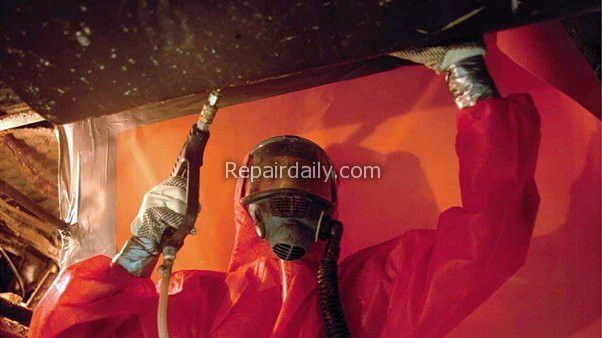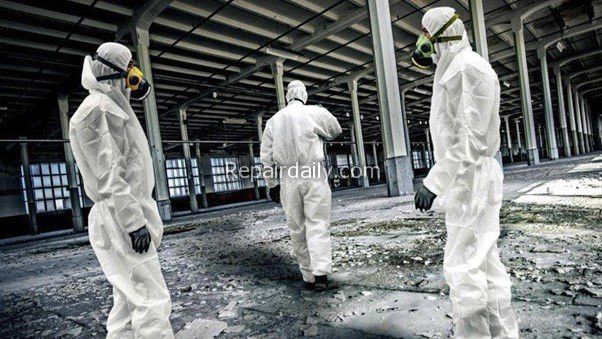
Conducting all asbestos removal or abatement work must be done by competent persons who have enough training, experience, and knowledge suitable to the nature of the work undertaken. This must be inclusive of practical training.
An asbestos awareness course is not enough. Regulation 16, together with Schedule 4 of the Safety, Health, and Welfare at Work (Asbestos) Regulation 2006, highlights the evidence a contractor can provide to show their competence to perform asbestos work.
Asbestos is a fatal carcinogen that licensed asbestos abatement professionals should only undertake. While you can get information online about do-it-yourself asbestos abatement, advice is that you do not try to disturb asbestos-containing materials in any way.

Suppose you come across friable asbestos products in your home. In that case, you may cautiously wet them to hinder them from producing fibers until you can get licensed personnel to assess your home. These professionals are adequately trained and certified to follow all federal and state laws governing asbestos abatement and disposal.
If you do not get a professional, you are likely to break one of the many laws that regulate asbestos, and by that, you run the risk of facing a severe fine or penalty. The process of asbestos abatement entails:
1. Planning the Project Appropriately
Licensed and trained professionals like asbestos removal Auckland know how to assess the severity and size of the abatement project. This is important to local officials who supply permits for various types of asbestos-abatement projects.
2. Preparing the Work Area
The work area must be covered and sealed off with plastic sheeting and negative air pressure units to manage contamination outside the work area. Surfaces that do not require abating must be in plastic sheeting.

Posted warning signs must be there to make others aware that an asbestos project is underway.
3. Wearing Personal Safety Protection
Manufacturing of personal protective clothing should be from materials that provide safety and protection against fiber penetration and not from wool that attracts fibrous dust. There should be an inspection of all equipment and tools used to remove asbestos before the asbestos removal work.

After any repairs, there should be an inspection of the equipment; additionally, the tools should at least once every seven days get inspected when they are in continuous use. There should be a maintaining register with the state of the equipment, details of these inspections, and any repair details.
4. Safety Protocols in the Work Area
Deactivating the HVAC systems is essential to prevent the circulation of asbestos fibers. Workers should use a HEPA vacuum to clean asbestos off immovable objects to control dust. A HEPA vacuum is for cleaning up the area when the abatement is over.
5. Laundering clothing
Disposable coveralls should be worn as protective clothing unless it is not rationally practicable to do so. When using non-disposable protective clothing, the washing of the clothing should be in an appropriate laundering facility equipped to launder asbestos-contaminated clothing.
Cleaning of contaminated protective clothing should not take place in homes. Any clothing worn under coveralls must be disposed of or bagged adequately for laundering as asbestos-contaminated clothing.
6. How to Handle Asbestos Waste
Asbestos-containing materials are made wet before any removal efforts. Workers must be wearing a respirator and personal safety protection as they work with contaminated materials. All asbestos waste we get during the project should be wet before it is double bagged in 6-millimeter plastic bags and bound in a plastic, leak-tight container with a lid and proper labeling.
The disposal can be in special landfills designated to receive asbestos waste.
7. Creating Decontamination Units
Decontamination enclosure systems enable workers to remove contaminated clothing, shoes, and tools. A decontamination plan should be created and set up before any personnel or equipment may enter areas where the likelihood for vulnerability to hazardous substances is.
The decontamination plan should; Outline the number and layout of decontamination stations, determine the decontamination equipment needed and determine appropriate decontamination methods. Additionally, it should establish procedures to prevent contamination of clean areas and establish ways to minimize worker contact with contaminants during the removal of personal protective clothing and equipment (PPE).
8. Following Decontamination Procedures
Professionals must follow precise steps to remove contaminated protective clothing and equipment safely. These procedures safeguard worker safety and prevent workers from tracking asbestos into their homes.

9. Post-clean-up
After meeting the clearance standards, the abatement contractor should remove the containment barriers and reclean the work area using HEPA vacuuming. Upon completion, you should receive a report from your abatement contractor containing site logs, waste shipment records, copies of all licensing, and permits.
You should also get a report from your industrial hygiene firm, including copies of inspection results and laboratory analysis. Filing of these records is essential for compliance with environmental regulations.
Conclusion
Even though banning the production of asbestos was nationwide in the 1970s, this toxic substance persists mostly in older buildings to this day. It may shock you to learn that asbestos has never had a total outright ban from use in the United States, so in many of these older buildings, asbestos-containing building materials are still prevalent.
Most often in the insulation, fireproofing, flooring, roofing, adhesives, and other areas. Once an inspection and asbestos abatement is over, the asbestos contractor must submit an abatement record within 30 days to the owner. These recordkeeping necessities are set by the United States Environmental Protect Agency (EPA) and state agencies.
